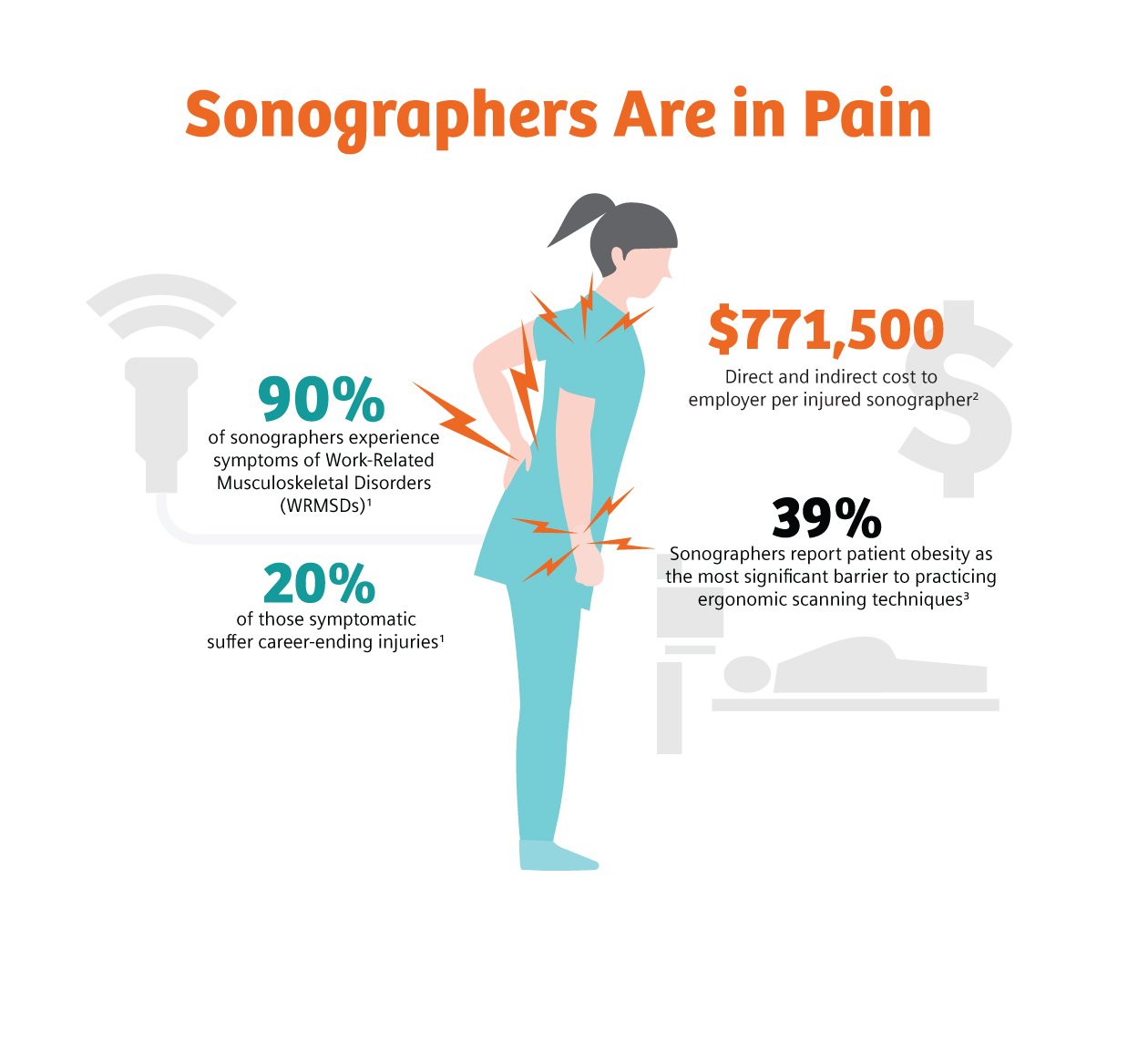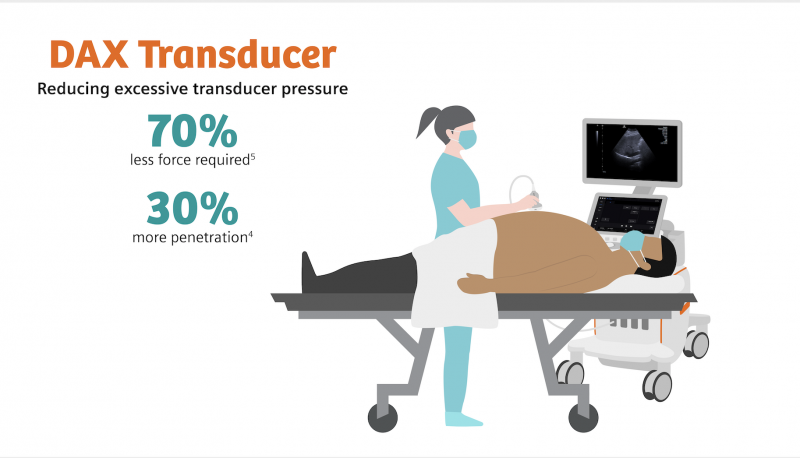
There is a high incidence of ultrasound work-related musculoskeletal disorders (WRMSD) among sonographers. Aside from the lasting personal toll, sonographer injury intensifies workforce shortages, which can cause unexpected operational and financial challenges for your ultrasound department. An injured sonographer’s direct and indirect costs have been estimated at $771,500 for employers, which includes worker’s compensation, the average cost of medical expenses, lost revenue and recruiting a new or temporary sonographer.2 An injured sonographer can be detrimental to institutions and clinics facing financial strain and lack of workforce readiness due to COVID-19.
How to Reduce WRMSD, According to a Sonographer
“There are multiple pieces of the puzzle to help prevent work-related musculoskeletal disorders in ultrasound and everyone plays a role to help reduce incidence and impact,” said Deanna Passarelli, RDMS, RVT, a clinical sonographer and sonography instructor. “It is important that sonographers and employers have control measures in place and share a culture of safety. Also, ultrasound and equipment manufacturers must design their equipment, systems and transducers with a focus on continually improving ergonomics. The ultrasound system must be able to adapt to the sonographer’s ergonomic needs while scanning; the sonographer shouldn’t have to conform to the system. We teach our students to utilize all the ergonomic features on a system that help them practice good technique, but not all systems offer the same adaptability. Another important component is the ease of acquiring an image. High-quality imaging should be attainable without having to place excessive pressure against the patient.”
Excessive Transducer Pressure is a Major Risk Factor
Patient obesity is reported as the most significant barrier to practicing ergonomic scanning technique according to a recent publication on the ergonomic scanning techniques for sonographers.3
Although equipment position changes and modifications of work postures can reduce injury risk, one factor in which sonographers have no control over is patient body habitus. Sonographers often need to exert excessive transducer pressure while scanning to provide diagnostic-quality images of obese patients. This pressure can result in a rapid onset of pain and muscle fatigue. With a rise in the obese population, injuries related to transducer pressure are likely to grow.
Excessive transducer pressure is consistent with the high incidence of shoulder, hand, and wrist pain. Throughout a sonographer’s career, the additional force required by traditional transducers will have a cumulative negative impact on the arm and shoulder muscles. When this force is added to the muscle firing required to maintain arm abduction or excessive reach to the patient, the injury risk increases significantly.
According to Passarelli, “When performing an abdomen exam on an obese patient, you often have to push the transducer against the patient’s abdomen much harder than you would when scanning a thin patient due to the increased adipose tissue. This repetition and the constant force required is physically demanding. I have been a sonographer for more than 25 years and I, unfortunately, fall under 90 percent of sonographers with a shoulder injury. I recently underwent shoulder surgery to help reduce the pain and improve my range of motion. Technology that can reduce the amount of pressure needed on the larger patients while still providing high-quality imaging could be a significant aid in helping to reduce strain during an exam.”
An Innovative Solution to Reduce Transducer Pressure
The ACUSON Sequoia ultrasound system from Siemens Healthineers is designed to adapt the signal to each patient’s bioacoustics characteristics. The ACUSON Sequoia also powers the patented and industry-exclusive Deep Abdominal Transducer (DAX), enabling unprecedented imaging throughout 40 cm depth through an advanced form of Multi-D beam formation. This level of penetration is a 30 percent improvement compared to conventional ultrasound.4 This novel approach enables the DAX to obtain clinically relevant information on high body mass index (BMI) patients when conventional transducer technology fails.
In an ergonomic assessment by Sound Ergonomics, an analog pull-push force gauge by M&A Instruments, Inc. was used to provide a quantitative estimation of the amount of transducer pressure exerted while scanning. Using this tool, a Sound Ergonomics consultant scanned a large model patient to obtain similar abdominal aorta images with a conventional ultrasound transducer and the DAX transducer. The DAX transducer required approximately 70 percent less force than the conventional transducer on a large model patient.5 Using the ACUSON Sequoia with DAX transducer can help to reduce the transducer pressure and decrease muscle strain when scanning high BMI patients compared to conventional transducer technology.
“We can’t forget about the patient experience either … It doesn’t feel good to have a transducer forcefully pressed into your ribs or abdomen … the reduced pressure required with the DAX throughout the exam will be appreciated by the patient as well,” said Passarelli.
Conclusion
The incidence of WRMSD in ultrasound is on the rise along with an increase in the obese population. The causes of WRMSD in sonographers are multifactorial, necessitating a variety of solutions to reduce the risks. These solutions include changes in the individual’s work postures and patient scheduling and replacing older equipment with those with the most current ergonomic features.
To mitigate the various costs of sonographer injury, the ACUSON Sequoia was designed to align industrial design and imaging architecture with industry recommendations and best practices to optimize the entire ergonomic experience. This design includes an industry-exclusive solution to help reduce the injury risk resulting from scanning obese patients with the ACUSON Sequoia and DAX transducer.
“The ACUSON Sequoia is a well thought out ultrasound system. Combining the lightweight, adaptable design with powerful imaging automation and the DAX transducer, you will be one step closer to reducing your risks of a work-related injury,” concluded Passarelli.
References:
1. Evans K, Roll S, Baker J. Work-Related Musculoskeletal Disorders (WRMSD) Among Registered Diagnostic Medical Sonographers and Vascular Technologists: A Representative Sample. J. Diagnostic Med. Sonogr. 2009;25(6):287-299.
2. Sound Ergonomics. Cost of injury. https://www.soundergonomics.com/cost-of-injury.html. Accessed Oct. 15, 2020.
3. Scholl, C., and Salisbury, H. (2017). Barriers to Performing Ergonomic Scanning Techniques for Sonographers. J. Diagnostic Med. Sonogr. 33, 406–411.
4. Compared to ACUSON S3000 ultrasound system
5. Data on File — (The force exerted with the 5C1 transducer was an average of 4.5N or 1.01 pound-force (pounds of force). The force exerted with the DAX transducer was an average of 1.3N or 0.3 pound-force (pound of force).



 December 23, 2025
December 23, 2025 









